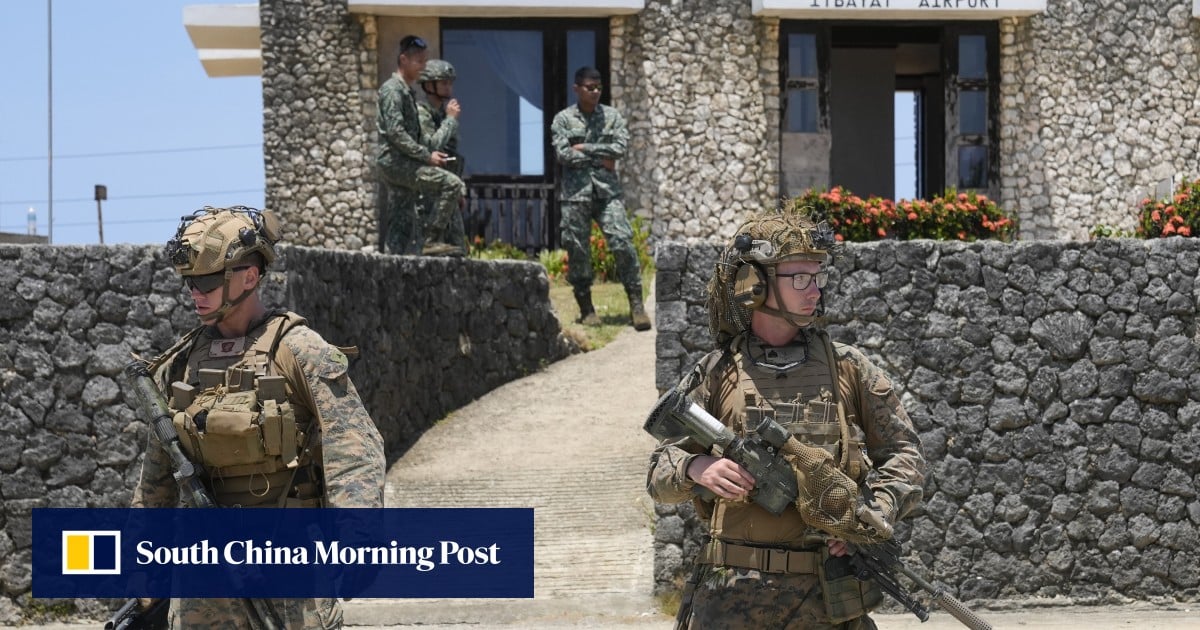Their exercise mission was to retake the remote island, which lies along the strategic Bashi Channel, from a foreign invader.

More than 11,000 troops from the United States and 5,000 from the Philippines, as well as 150 Australian and 100 French armed forces, are taking part in this year’s edition of the Balikatan, which began on April 22 and run until Friday. For the first time, some of this year’s exercises are taking place beyond the 12 nautical-mile boundary of the Philippines’ territorial waters. Fourteen other nations sent “observers”.
The presence of two Chinese navy ships in the South China Sea during the group sail exercise prompted Balikatan 2024 spokesman Army Colonel Michael Logico to say on April 30: “I thought there are just 14 countries that will be sending observers. Apparently, there is a 15th country that sent observers.”
Washington-based defence journalist Aaron Matthew Lariosa, who writes for the US Naval Institute and Naval News and has covered multiple Balikatans, said a similar island-retaking exercise during last year’s event took place on an island facing the South China Sea rather than the northern Philippines.
He said this year’s exercise was different from the previous one because it appeared to be in preparation for a real-world scenario – that of hostilities breaking out over Taiwan.
Such a conflict could have serious ramifications for the Philippines, even if it was not directly involved in the hostilities, he noted.
“Given the Philippines’ proximity, a cross-strait crisis can have very tangible spillover effects in [terms of] either refugees fleeing the conflict or military forces occupying the strategic islands for their own use,” he told This Week in Asia on Tuesday.
“It should be remembered that the Batanes [islands, which include Itbayat] were the first [areas] occupied by the Japanese in their invasion during the Pacific War.”
Ricardo Jose, a professor of history at the University of the Philippines specialising in World War II, noted that in 21st century warfare, the Batanes islands could provide an ideal location to conceal small, mobile missile systems such as the US Army’s Typhon missile launcher, which made an appearance at this year’s Balikatan and has a range of 370km.
“The islands are very remote, isolated, they’re difficult to get to with rugged terrain and rapidly changeable weather.
“Under camouflage and because they are smaller and more mobile, it’s also easier to conceal [missile launchers like the Typhon]” from even spy satellites, he said.
The Typhon missile system was not fired during the Balikatan, but one such system was included in the exercises to test how viable it was to deploy them on land by airlifting them in.

Besides the island-retaking drill, Monday also saw a separate exercise focused on repelling an invasion force, which took place along the sand dunes of Laoag in Ilocos Norte on the northwestern tip of Luzon.
This large-scale war game included 150 Australian soldiers from the first battalion of the Royal Australian Regiment.
The climax of the 19-day war exercises will take place on Wednesday with a multilateral “maritime strike” or sinking of the BRP Lake Caliraya, a 4,700-tonne Philippine navy vessel built in China.
The Philippine navy will, for the first time, fire an SSM-700K C-Star (Haeseong) anti-ship cruise missile at the Caliraya, which was towed on Tuesday to its target location beyond the 12 nautical-mile boundary of the Philippines’ exclusive economic zone.

Logico said in the same briefing that the military chose locations “that gave us the most training value, the most challenges” – including tackling weather and capability issues, and “how to integrate the capabilities of our treaty allies”.
“What makes this [year’s] exercise notable is its occurrence during the Armed Forces of the Philippines’ shift to the Comprehensive Archipelagic Defence Concept, which looks to orient the country’s military against external threats,” Lariosa noted.
“However, due to the weakness of its forces, the Philippines still has to remind potential aggressors that its only treaty ally is prepared to help in certain contingencies.”


